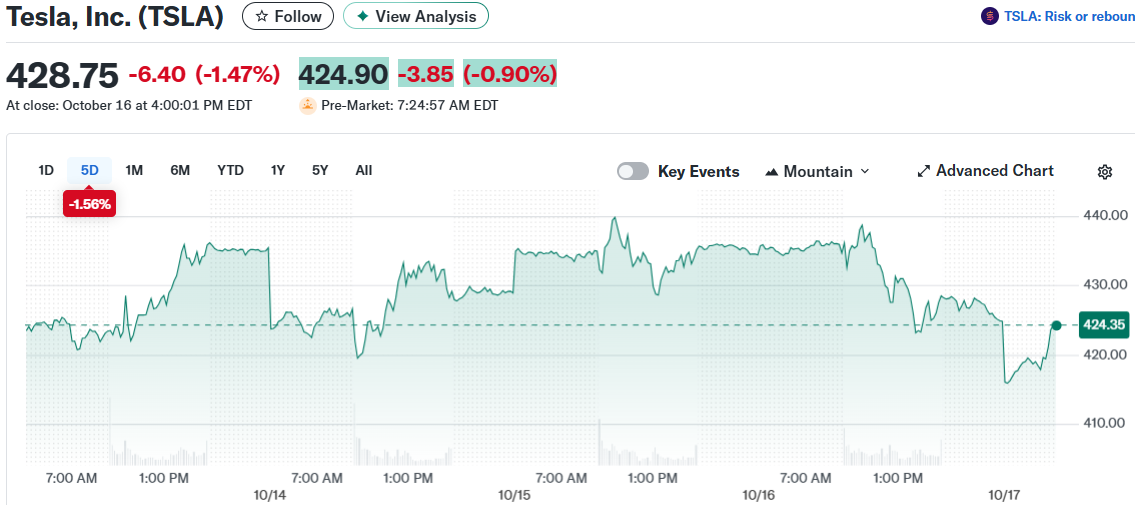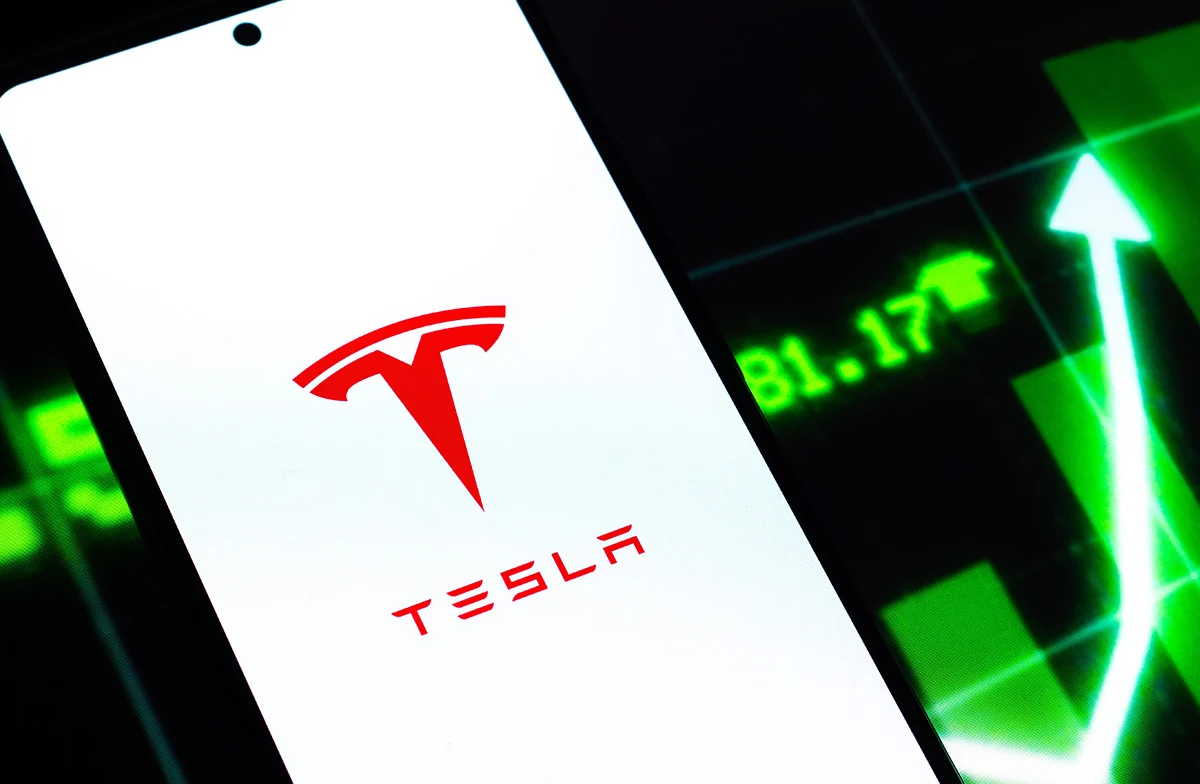TLDR
- Tesla reports record Q3 deliveries of 497,099 vehicles, beating Wall Street estimates by over 50,000 units as buyers rushed to claim the expiring $7,500 federal EV tax credit
- Options traders are showing bullish sentiment with call volume nearly twice that of puts, and the put/call ratio at 0.56 ahead of October 22 earnings
- New Model 3 and Model Y Standard editions launched at $36,990 and $39,990, but the modest $4-5K price cuts disappointed investors and caused a 4.5% stock drop
- Wall Street analysts remain divided with a Hold consensus rating, 16 Buy ratings versus 9 Sell ratings, and an average price target of $364 suggesting 16% downside
- Tesla stock trades around $429 after hitting a 52-week high of $453 on October 6, with analysts questioning if Q4 demand will hold after the tax credit expiration
Tesla stock closed around $429 on Thursday after a volatile few weeks that saw shares touch $453 earlier this month. The stock has given back some gains but remains up roughly 80% over the past year.

Options activity tells an interesting story ahead of next week’s earnings. The put/call ratio sits at 0.56, meaning traders are buying nearly twice as many call options as puts.
Call options are bets the stock will rise. Put options are bets it will fall.
Total options volume looks normal for Tesla. But the lopsided ratio toward calls suggests traders expect good news when the company reports results on Wednesday, October 22 after the market close.
The options market is pricing in about a 50% chance that Tesla moves more than 6.8% in either direction after earnings. That’s a pretty wide expected swing for a company worth over $1.4 trillion.
Analysts expect Tesla to report earnings of $0.54 per share for the quarter. That’s down from $0.72 in the same period last year.
Record Deliveries Beat Expectations
Tesla delivered 497,099 vehicles globally in Q3. That’s a new quarterly record and about 7.4% higher than last year.
Wall Street had been expecting around 443,000 deliveries. Tesla beat that estimate by more than 50,000 units.
The surge came as buyers rushed to take advantage of the $7,500 federal EV tax credit before it expired at the end of September. Tesla pushed hard on discounts and financing deals to drive sales.
CEO Elon Musk and the team clearly wanted to hit a big number. They got it.
But analysts warn this pull-forward demand could create problems. Ken Mahoney of Mahoney Asset Management said the credit expiration “could leave a U.S. demand gap in the fourth quarter.”
Tesla itself had warned about “a few rough quarters” after subsidies end. The company is counting on gains from self-driving software and energy storage to fill the gap.
Tesla’s energy business did set a record in Q3, deploying 12.5 GWh of storage capacity. That helps diversify revenue beyond car sales.
The big question for next week’s earnings is profit margins. Tesla cut prices to boost deliveries. Auto gross margins were already in the mid-single digits.
Investors want to know if the record volume came at the cost of profitability. Revenue should be strong but margins might be squeezed.
New Standard Models Get Lukewarm Reception
Tesla launched new entry-level versions of its Model 3 and Model Y on October 7. The Model 3 Standard starts at $36,990 and the Model Y Standard at $39,990.
These new trims cut about $4,000 to $5,000 from the previous base models. They have fewer features like no Autosteer and fewer speakers.
Musk has said Tesla needs a truly affordable car under $30,000 to reach mass-market buyers. These new models don’t get there.
Wedbush analyst Dan Ives said he was “disappointed” by the modest price cuts. The market agreed, sending Tesla stock down about 4.5% on October 8 when the details came out.
The new models are basically Tesla pulling a pricing lever rather than launching a breakthrough product. They’ll help move some units but won’t change the game.
Competition is heating up everywhere Tesla operates. In Europe, Tesla’s market share has fallen to about 1.5% as sales dropped 22.5% in August compared to last year.
Chinese rivals like BYD keep expanding. Legacy automakers like BMW, Volkswagen and Ford are launching new EV models every quarter.
Even in China where Tesla has a big factory, the company faces pressure. The new six-seat Model Y L variant helped deliveries rise 2.8% in September, reversing a summer dip.
Global EV sales hit a record 2.1 million units in September alone, up 26% from last year. But Tesla has to fight harder for every sale in that growing market.
Wall Street Remains Split
Morgan Stanley analyst Adam Jonas maintained his Buy rating on Tesla this week. Jonas has long been bullish on the company’s EV growth potential and sees Tesla as well-positioned in sustainable transportation.
But Jonas warned that Tesla’s early lead in physical AI and robotics is shrinking. All the big tech companies are now investing heavily in robotics, creating more competition.
Tesla has worked on robotaxis for over ten years and the Optimus robot for nearly five. That head start matters less now.
Wall Street as a whole is neutral on Tesla. The consensus rating is Hold with 16 Buy ratings, 13 Holds and 9 Sells.
The average price target is $364. That implies about 16% downside from current levels around $429.
Bulls like Wedbush’s Ives see Tesla reaching $600 within 12 months. He points to the company’s technology lead, booming energy business and self-driving potential.
Morgan Stanley’s target is around $410. Piper Sandler recently raised its target to $500.
These bulls argue Tesla deserves a premium valuation because it’s as much a tech and AI company as a carmaker. The stock trades around 250 times forward earnings.
Bears counter that valuation is way too high. HSBC Research has a Reduce rating with a $127 price target, though that’s an outlier.
The average target of $364 suggests most analysts think the stock has run too far. About half rate it Hold or Sell.
A new NHTSA investigation into Tesla’s Full Self-Driving software is also hanging over the stock. The probe covers about 2.9 million vehicles over reports of cars running red lights.
When that investigation was announced on October 9, Tesla shares dropped about 2%. Regulatory issues remain a wildcard for the stock.
Tesla stock gained 1.38% on Thursday, closing the week with traders positioned for next Wednesday’s earnings report through heavy call option buying.






